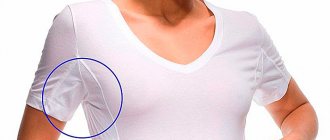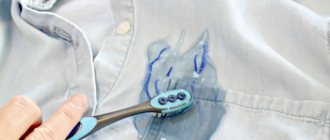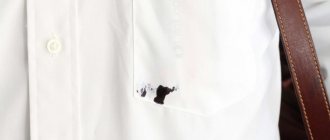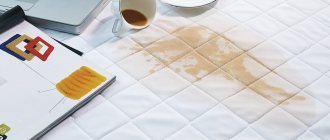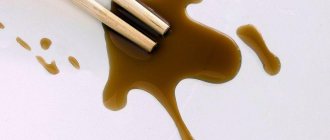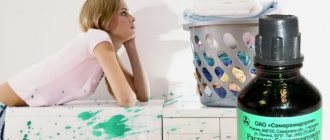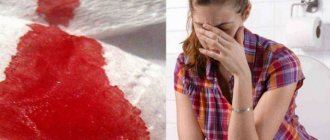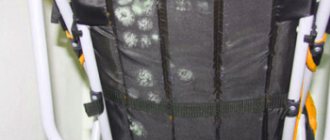Get lost, unclean: how to remove traces of makeup from clothes
Lipstick, self-tanner, nail polish, and how to take it off
A hackneyed movie image with a trace of red lipstick on the collar of a white men's shirt hints at a romantic twist in the plot. In real life, makeup stains on your favorite dress or bag are more likely to turn into tears.
Dropped a nail polish brush on your new jeans? Met with brightly painted lips and a scarf? Or – well, who hasn’t happened to you – they wiped off the foundation from their face with the collar of their T-shirt? Before you panic and frantically scrub the stained item with a napkin, take a deep breath and calmly get down to business. We'll fix everything! Especially if you follow the instructions.
How to remove a drawing on a wall?
You can remove permanent marker from the floor or wall using any toothpaste. Just apply it to a damp cloth, preferably microfiber, and wipe the pattern. Any aerosol, for example, hairspray or deodorant, can also easily remove a marker stain. Spray it on the “art” and rinse with water.
Interesting materials:
Where can I get a certificate of Russian citizenship? Where can I get the citizenship leaflet? Where can I register a foreign citizen at his place of stay? Where can I register a foreign citizen in my apartment? Where can a foreign citizen register? Where can a foreign citizen register? Citizens of the EAEU, who is included there? How long can Moldovan citizens stay in Russia? Who are the citizens in reserve? Who is this EU citizen?
Using dishwashing liquid or soap
What works well for removing stains is dishwashing liquid.
- In this case, you need to moisten the sponge in warm water and apply a little detergent to it.
- Then the stain is rubbed in a circular motion.
- After you see that it has disappeared, wash the treated area with warm water and let it dry.
If you can’t remove the defect the first time, apply detergent to the stain and leave it for a day. Then all that remains is to wash it. It is important to set the washing machine to a program that suits your material.
How to wash a pencil? There are several more ways.
- Lather the graphite strips with laundry soap.
- Leave them for half an hour.
- Rinse, lather again, wash.
- Then all that remains is to rinse the fabric thoroughly.
Mascara and eyeliner
It’s not for nothing that special two-phase removers are produced for mascaras and eyeliners, especially waterproof ones: you can’t just get rid of them. It makes sense to use these makeup removers if mascara ends up not only on your eyelashes, but, for example, on your sleeve. Follow the protocol: shake the bottle well, apply a little liquid to a cotton pad, lightly blot the stain and wash. To avoid having to deal with oil stains from a two-phase toner, use micellar water. It consists of special particles, micelles, which adhere to dirt molecules and are washed away along with them.
Wash
Getting rid of a simple pencil lead on fabric can also be done by washing. But this method does not always help. However, if the powder is strong, then it can cope with the problem.
Important! Before you start washing, it is better to soak the product for a day.
If there is no effect, you can take the item to the dry cleaner. They should be able to remove such stains. If this doesn't help, try all of the above options. One of them must come up, the main thing is not to give up and fight to the last.
Hair dye
Hair dye marks on a towel or T-shirt are one of the most difficult cases. If a cocktail of equal parts of ammonia and hydrogen peroxide or ammonia and water in a ratio of 1:5 with the addition of salt (a teaspoon per glass of solution) does not help, you will have to buy a stain remover. Or use this thing for further hair coloring at home.
If you can't get rid of the stain on the first try, repeat one or more times until the end. If all else fails, go to the dry cleaner.
Removing makeup stains from fabric can be a daunting task if you don't know a few simple rules. Keep in mind that different cosmetics react differently to detergents and the success of the wash depends on whether you make the right decision in each case.
When removing stains, it is important to consider not only the composition of the substance that led to the contamination, but also the composition of the fabric. So, for example, if we are talking about such delicate fabrics as silk or fine wool, and the stain is clearly not easy, then you should put aside experiments and contact professional cleaning. In such cases, it is better to rely on experience and reassure yourself that if the situation worsens, you will be compensated for your loss.
General rules for removing stains
1. Fresh (not older than three hours old) stains are easier to remove than dried and firmly absorbed stains. Therefore, we must act quickly.
2. If the stain is fresh, first blot it with a dry paper towel so that it absorbs as much of the cosmetic as possible. Now sprinkle the stain with salt or baby powder, they absorb grease very well.
3. If several hours have passed since the incident and the stain has dried, remove the top layer with a plastic spoon.
4. Remove the stain from the wrong side of the fabric by placing paper napkins underneath.
5. Never rub the stain: it will only absorb it more thoroughly. The movements should be blotting.
6. When purchasing a stain remover, be guided by the type of stain and the type of material that needs cleaning. Please read the instructions first and strictly follow them.
7. For any stain removers, both homemade and industrial, first test on a small area of fabric, not the most visible part of the product. If the color remains the same, you can proceed.
8. Begin removing dirt using a weak solution. If necessary, gradually increase the concentration.
9. Peroxide and other stain-fighting products should not be poured onto the stain, but applied with soaked cotton pads or a soft-bristled toothbrush (for example, for very young children). First, treat the area around the stain, then the edges, and only then start working on the middle. This technique will prevent the stain from spreading.
Recommendations for cleaning different types of fabric
A pen stain may end up on your favorite trousers, a stylish sweater or a light T-shirt. In order not to spoil the item, when cleaning you must take into account the type of fabric . The wrong cleaner can corrode light-colored fabric or ruin its shade.
| Textile | What will help remove ink? | What can't be used? |
| Suede | Stiff brush, stationery eraser, special suede cleaner | Strong chemicals and solvents |
| Leather | Table salt | Strong chemical solvents |
| Linen | Hairspray, alcohol, vinegar solution | Chlorine |
| Synthetic fabric | Vinegar, glycerin | Products containing acetone |
| Chintz | Vinegar, branded stain removers, alcohol | Aggressive stain removers in large quantities |
| Cotton | Hairspray, acetone, alcohol, hydrogen peroxide | Chlorine |
| Silk | Milk, kefir, glycerin | Acetone, acetic acid |
| Wool | Milk, glycerin | Acetone, chemical solvents |
If you have doubts about the type of fabric, it is better to have the item dry cleaned by professionals. You can learn how to wash a pen from a white shirt here.
Store products
A simple pencil from embroidery can be removed with purchased products, which are more than abundant in the household chemicals store. Most often, stain removers are chosen for such purposes, and oxygen bleaches are used for natural white fabrics. The rules for using the product are as follows:
- Before use, be sure to conduct a test. To do this, apply the product on the back side or on a small piece of such fabric. Leave for 10-15 minutes, if during this time the fibers have not deteriorated, then the product can be safely used for its intended purpose.
- Study the instructions carefully and strictly adhere to them at all stages of use.
- Chlorine-containing products are contraindicated for use; they will remove the pencil mark along with the thread colors.
The best stain remover is considered to be ordinary laundry soap; washing powder, dishwashing detergent, and stain soap are often used. Vanish and As will also help remove the pencil from the fabric, but the dosage should be strictly adhered to.
Laundry soap
Regular soap 72% will effectively remove marking marks from white fabric. To do this, soak the item in warm water, rub it with soap and leave it in the liquid for half an hour. After contamination, treat with the product again and wash. Rinsing will show the effectiveness of the product; if the traces are not completely removed, you can repeat the procedure.
Vanish
Before washing a simple pencil from the canvas in the washing machine, treat it with Vanish. To do this, place a cloth with contamination in a basin and apply gel on top, leaving for 4-5 hours without water. Then fill it with water, and additionally remove contamination with soap. Let it sit for no more than 20 minutes, wash and rinse. For very noticeable marks, you can use a stiff brush from the reverse side. The washing machine will help fix the result; if necessary, the procedure can be done again.
Liquid detergent
Pour a sufficient amount of water into the container and make a strong soap solution with any detergent for colored clothes. Dip the fabric there and leave it overnight. In the morning, wash the product thoroughly and rinse well.
Dish detergent
A simple pencil from embroidery can be removed with dishwashing detergent in tandem with ammonia. Apply the product to the entire contaminated surface and rub lightly. Then rinse and add a few drops of ammonia, rub again, apply detergent, and immerse in water. Washing and rinsing will consolidate the achieved result.
Important! To process white fabrics, only transparent products are used; dyes can additionally color the fabric.
For heavily ingrained stains, use a collection agent to remove traces. It is prepared from:
- Antipyatnin soap
- laundry soap,
- oxygen bleach,
- liquid laundry detergent,
- dishwashing detergent.
All ingredients are mixed in equal proportions and applied for a day. This is followed by soaking for at least 8 hours and rinsing. If not all marks have been removed, then use a cleaning agent and a stiff brush. But these are already radical measures.
Process
Beauty products can be oil-based (cream) or contain no fat at all (powder). This will depend on your choice in the store or homemade solution for removing cosmetics. A universal remedy that works with most types of stains is ammonia and salt diluted in water, but it is not omnipotent. Therefore, let’s look at each type of cosmetics in more detail.
PHOTO getty images
All of these and other creamy beauty products are mostly made up of oils and/or waxes. You can’t wash them with plain water; on the contrary, it will worsen the situation. You will need fat dissolving agents.
First way. The simplest and most affordable means for removing traces of lipstick or tone from fabric is dishwashing detergent or shampoo. Take something that does not contain moisturizing components - there is no need for excess fat in this case. After the steps with a napkin and salt, apply a little product (a couple of drops in a 1:2 ratio to water is enough) and leave for five minutes. Then rinse with warm water.
Second way. Spray hairspray onto the stain. Leave for 10 minutes, then wipe with a clean cloth or sponge. Wash it.
Third option. Sprinkle baking soda on the stain, and after a few minutes, extinguish it with a mixture of warm water and lemon juice or vinegar. And throw it in the wash.
Number four is a 3% hydrogen peroxide solution. It is especially effective against self-tanners and other cosmetics with orange pigment.
Sprinkle traces of blush, eye shadow, powder with washing powder. After 15 minutes, wash in the manner recommended for the affected item.
PHOTO getty images
Store products
A simple pencil from embroidery can be removed with purchased products, which are more than abundant in the household chemicals store. Most often, stain removers are chosen for such purposes, and oxygen bleaches are used for natural white fabrics. The rules for using the product are as follows:
- Before use, be sure to conduct a test. To do this, apply the product on the back side or on a small piece of such fabric. Leave for 10-15 minutes, if during this time the fibers have not deteriorated, then the product can be safely used for its intended purpose.
- Study the instructions carefully and strictly adhere to them at all stages of use.
- Chlorine-containing products are contraindicated for use; they will remove the pencil mark along with the thread colors.
The best stain remover is considered to be ordinary laundry soap; washing powder, dishwashing detergent, and stain soap are often used. Vanish and As will also help remove the pencil from the fabric, but the dosage should be strictly adhered to.
Laundry soap
Regular soap 72% will effectively remove marking marks from white fabric. To do this, soak the item in warm water, rub it with soap and leave it in the liquid for half an hour. After contamination, treat with the product again and wash. Rinsing will show the effectiveness of the product; if the traces are not completely removed, you can repeat the procedure.
Before washing a simple pencil from the canvas in the washing machine, treat it with Vanish. To do this, place a cloth with contamination in a basin and apply gel on top, leaving for 4-5 hours without water. Then fill it with water, and additionally remove contamination with soap. Let it sit for no more than 20 minutes, wash and rinse. For very noticeable marks, you can use a stiff brush from the reverse side. The washing machine will help fix the result; if necessary, the procedure can be done again.
Liquid detergent
Pour a sufficient amount of water into the container and make a strong soap solution with any detergent for colored clothes. Dip the fabric there and leave it overnight. In the morning, wash the product thoroughly and rinse well.
Dish detergent
A simple pencil from embroidery can be removed with dishwashing detergent in tandem with ammonia. Apply the product to the entire contaminated surface and rub lightly. Then rinse and add a few drops of ammonia, rub again, apply detergent, and immerse in water. Washing and rinsing will consolidate the achieved result.
Important! To process white fabrics, only transparent products are used; dyes can additionally color the fabric.
For heavily ingrained stains, use a collection agent to remove traces. It is prepared from:
- Antipyatnin soap;
- laundry soap;
- oxygen bleach;
- liquid detergent;
- dishwashing detergent.
All ingredients are mixed in equal proportions and applied for a day. This is followed by soaking for at least 8 hours and rinsing. If not all marks have been removed, then use a cleaning agent and a stiff brush. But these are already radical measures.
We found out how to wash a pencil, but in order not to fool around and waste energy, you can try some tricks:
- Before you start using a whole bunch of household chemicals, try removing the pencil with a regular school eraser; this often turns out to be the most effective.
- Bread crumb will also give a good result; a loose ball is formed from it and passed over the dirt. The bread will literally pull the marks onto itself. Afterwards, carefully shake off the crumbs and wash the product.
- To avoid the question of how to remove pencil marks from white, you can starch the fabric before applying the markings. After carrying out the necessary work, it is enough to wash everything in warm water with a small addition of detergent.
- You should try scraping off the pencil from furniture and carpeting with a dull knife and then treating it with dishwashing detergent. If the traces do not give in, then heavy artillery is used; WD-40 aerosols are applied to this type of pollution.
You can wash a simple pencil from a white fabric, the main thing is to wisely use all the methods described above. But it is best to use threads or special markers for marking, which will not be difficult to remove.
Many needlewomen “the old fashioned way” use a pencil to mark seams, patterns and ornaments. However, washing a simple pencil from canvas and white fabric is not an easy task. Special products that can be easily prepared at home will help you deal with strokes.
Recipe for an effective soap product. Required components:
- Antipyatin soap;
- laundry soap;
- oxygen bleach;
- synthetic detergent;
- dishwashing liquid.
Mix the ingredients in one bowl and stir thoroughly. Apply the prepared product to the contaminated surface, leave for a day, and then soak in warm water for 7-8 hours. If traces remain, add a little synthetic cleaner to the water. Rinse the fabric thoroughly under running water to remove any residue. Additionally, wash in a washing machine with a suitable program.
Nail polish
Removing regular (non-gel) nail polish from fabric is almost as easy as removing it from your fingernails. Just don't reach for the bottle of acetone. If you accidentally spill polish on your dress, let it dry and then tape it down. Rip off the tape with a sharp movement, as if it were a wax strip for hair removal. The varnish should leave a pale trace that can be removed by the washing machine. If trouble happens to your favorite leather jacket or bag, after removing the stain, apply leather furniture conditioner to the damaged area. Follow the instructions on the package and be sure to wear rubber gloves.
How to remove ink from white clothes using traditional methods
There are many folk recipes to help cope with this problem. Among them, the following remedies showed the greatest effectiveness:
In order to completely wash the handle without damaging the white fabric, you should carefully study the nuances in the use of each of the above products.
How to wash handles from white clothes with acetone
Perhaps one of the fastest ways to remove pen stains is to apply acetone to white fabric. Thus, you can remove contaminants from almost any material. However, applying acetone directly to clothing can damage fabric fibers, so it is mixed with ethyl alcohol in a 1:1 ratio. Then proceed according to the following scheme:
It should be remembered that even in diluted form, acetone is a fairly powerful agent and is not suitable for removing ink marks from delicate items made of thin material, otherwise, along with the pigment, it will also corrode the fabric. You can prevent damage to items if you do not ignore the inscriptions on the clothing label.
How to remove ink stains from white ammonia
Ammonia can also be quite effective when it comes to removing blue pen from white clothes, especially if used in combination with baking soda:
How to remove a pen stain on white with laundry soap
When it comes to removing ballpoint pens from white things, do not forget about the effectiveness of laundry soap. It is quite capable of dealing with contamination on its own, but it is often used together with ethyl alcohol:
How to remove ink stains from white clothes with hydrogen peroxide
Hydrogen peroxide comes in handy if you need to safely remove pen from white clothing, such as a child's school blouse or pajamas. You can also increase the effectiveness of peroxide if you combine it with ammonia in a 2:1 ratio. This solution is then applied to the contaminated area and allowed to soak for 10 - 15 minutes. After which the item should be washed in the usual way to get rid of any remaining ink.
How to remove pen paste from white clothes with alcohol
Vodka or ethyl alcohol will help restore cleanliness to white clothes and get rid of pen stains:
This method can remove not only fresh ink stains, but also old ones.

